
Here are the rules for proper display and use of the United States Flag, as established by generally accepted custom and by Public Law 94-344 approved by Congress and signed by the President of the United States.
Rules covered by the code are indicated (parenthetically) by reference to the corresponding code section and paragraph. Example (Sec. 2, a).
| 1. | It is the universal custom to display the flag only from sunrise to sunset on buildings and on stationary flagstaffs in the open. However, when a patriotic effect is desired, the flag may be displayed twenty-four hours a day if properly illuminated during the hours of darkness. (Sec. 2, a). |
| 2. | The flag should be hoisted briskly and lowered ceremoniously. (Sec. 2, b). |
| 3. | The flag should not be displayed on days when the weather is inclement, except when an all weather flag is displayed. (Sec. 2, c). |
| 4. | The flag should be displayed on all special days (Sec. 2, d), especially on: |
New Year's Day, January 1
Inaugural Day, January 20
Lincoln's Birthday, February 12
Washington's Birthday, third Monday in February
Easter Sunday (variable)
Mother's Day, second Sunday in May
Armed Forces Day, third Saturday in May
Memorial Day (half-staff until noon), the last Monday in May
Flag Day, June 14
Independence Day, July 4
Labor Day, first Monday in September
Constitution Day, September 17
Columbus Day, second Monday in October
Navy Day, October 27
Veterans Day, November 11
Christmas Day, December 25
birthdays of States (date of admission)
and on State holidays.
and such other days as may be proclaimed by
the President of the United States
| 5. | The flag should be displayed daily on or near the main administration building of every public institution (Sec. 2, e). |
| 6. | The flag should be displayed in or near every polling place on election days. ( Sec. 2, f). |
| 7. | The flag should be displayed during school days in or near every schoolhouse. (Sec. 2, g). |
| 8. |  When the Flag is displayed from a staff projecting from a
window sill, balcony or building front the union of the Flag should always be at the peak
of the staff unless the Flag is at half-staff. When suspended over a sidewalk from a rope
between a building and a pole at the edge of the sidewalk, the Flag should be hoisted out
from the building, union first. (Sec. 3, h). When the Flag is displayed from a staff projecting from a
window sill, balcony or building front the union of the Flag should always be at the peak
of the staff unless the Flag is at half-staff. When suspended over a sidewalk from a rope
between a building and a pole at the edge of the sidewalk, the Flag should be hoisted out
from the building, union first. (Sec. 3, h). |
| 9. |  When displayed over the middle of the street,
the Flag of the U.S.A. should be suspended vertically with the union to the north in an
east and west street, or to the east in a north and south street. Sec. 3, j). When displayed over the middle of the street,
the Flag of the U.S.A. should be suspended vertically with the union to the north in an
east and west street, or to the east in a north and south street. Sec. 3, j). |
| 10. | When carried in a parade front with other flags the U. S. Flag should always be to the marching right of the other flags, or to the front and center of the flag line. (Sec. 3). |
| 11. | When displayed on a float in a parade the U. S. Flag should be mounted on a staff or, if displayed flat, it should be so suspended that its folds fall free, as though the Flag were staffed. (Sec. 3,a). |
| 12. | The Flag should not be draped over the hood, top, sides, or back of a vehicle or of a railroad train or a boat. When the Flag is displayed on a motor car, the staff should be tied firmly to the chassis, or clamped to the right fender. ( Sec. 3, b). |
| 13. | The Flag should never be carried flat or horizontally, but always aloft and free. (Sec. 4,c). |
| 14. | During the ceremony of hoisting or lowering the Flag or when the Flag is passing in a parade or in review, all persons present except those in uniform should face the Flag and stand at attention with the right hand over the heart. Those present in uniform should render the military salute. When not in uniform, men should remove their headdress with their right hand and hold it at the left shoulder, the hand being over the heart. Aliens should stand at attention. The salute to the Flag in a moving column should be rendered at the moment the Flag passes (Sec. 5). |
| 15. | During the rendition of the national anthem when the Flag is displayed, all persons present except those in uniform should stand at attention facing the Flag with the right hand over the heart. Persons in uniform should render the military salute at the first note of the anthem and retain this position until the last note. When not in uniform, men should remove their headdress with their right hand and hold it at the left shoulder, the hand being over the heart. When the Flag is not displayed those present should face toward the music and act in the same manner they would if the Flag were displayed there. (Sec. 6). |
| 16. | The Pledge of Allegiance to the Flag should be rendered by standing at attention facing the Flag with the right hand over the heart. When not in uniform, men should remove their headdress with their right hand and hold it at the left shoulder, the hand being over the heart. Persons in uniform should remain silent, face the Flag, and render the military salute. (Sec. 7). |
| 17. | When flags of two or more nations are displayed they should be flown from separate staffs of the same height and the flags should be of approximately equal size (Sec. 3,g). |
| 18. |  When flags or pennants of states, cities or societies are
flown on the same halyard with the Flag of the U. S. A., the latter should always be at
the peak. When flown from adjacent staffs the U. S. Flag should be hoisted first and
lowered last. ( Sec. 3,f). When flags or pennants of states, cities or societies are
flown on the same halyard with the Flag of the U. S. A., the latter should always be at
the peak. When flown from adjacent staffs the U. S. Flag should be hoisted first and
lowered last. ( Sec. 3,f). |
| 19. | No other flag or pennant should be placed above or, if on the same level, to the right of the U. S. Flag, except during church services conducted by naval chaplains at sea, when the church pennant may be flown above the Flag during church services for navy personnel (Sec. 3,c) (Pub. Law 107). |
| 20. | When a number of flags of states or cities, or pennants of societies are grouped and displayed from staffs with the U. S. Flag the latter should be at the center and highest point of the group. (Sec. 3,e). |
| 21. |  When displayed with another flag, as illustrated, the U. S.
Flag should be to its own right, or the observer's left, with its staff over that of the
other flag. (Sec. 3,d). When displayed with another flag, as illustrated, the U. S.
Flag should be to its own right, or the observer's left, with its staff over that of the
other flag. (Sec. 3,d). |
| 22. | The U. S. Flag should not be dipped to any
person or thing. Regimental colors, state, city, organizational or other flags are dipped
as a mark of honor. (Sec. 4). Note: the above provision has one exception U. S. Navy vessels, upon receiving a salute by the dipping of the flag from a vessel registered by a nation which is formally recognized by the U. S., must return the compliment dip for dip. |
| 23. | Do not display the Flag of the U.S.A., with the union down, except as a signal of dire distress in instances of extreme danger to life or property. (Sec. 4,a). |
| 24. | Do not let the Flag of the United States touch anything beneath it, such as the ground, floor, water or merchandise. (Sec. 4,b). |
| 25. | The U. S. Flag should be a distinctive feature of a ceremony for unveiling a statue or monument, but the Flag should never be used as the cover for the statue or monument (Sec. 3, l). |
| 26. | On Memorial Day the Flag should be displayed
at half-staff until noon only, then raised to the top of the staff. (Sec. 3,m). By order of the President, the Flag shall be flown at half-staff upon the death of principal figures of the U. S. Government and the Governor of a State, territory, or possession, as a mark of respect to their memory. (Sec. 3,m). |
| 27. |  When displayed either horizontally or vertically against a
wall, the union should be uppermost and to the Flag's own right, that is, to the
observer's left. When displayed in a window, the Flag should be displayed in the same way,
with the union or blue field to the left of the observer in the street. (Sec. 3,i). When displayed either horizontally or vertically against a
wall, the union should be uppermost and to the Flag's own right, that is, to the
observer's left. When displayed in a window, the Flag should be displayed in the same way,
with the union or blue field to the left of the observer in the street. (Sec. 3,i). |
| 28. | The U. S. Flag should never be used as drapery, never festooned, drawn back, nor up, in folds. It should always be allowed to fall free. Bunting should be used for decoration. (Sec. 4,d). |
| 29. |  Blue, white and red bunting should be used
for covering a speaker's stand, draping a platform front or for general decorations. Such
bunting should always be arranged with the blue above, white in the middle and red below
(Sec. 4,d). Blue, white and red bunting should be used
for covering a speaker's stand, draping a platform front or for general decorations. Such
bunting should always be arranged with the blue above, white in the middle and red below
(Sec. 4,d). |
| 30. | When bunting is displayed vertically, the blue will be to the observer's left, white in the center and red on the right. |
| 31. | The Flag should never be fastened, displayed, used or stored in such manner as will permit it to be easily torn, soiled or damaged. (Sec. 4,3). |
| 32. | The Flag should never be used as a ceiling cover. (Sec. 4,f). |
| 33. | Never hang or drape the Flag in any position below the seats on a platform. (Sec. 4,d). |
| 34. |  When used on a speaker's platform, the Flag,
if displayed flat, should be above and behind the speaker. Use bunting to decorate a
speaker's desk or the front of the platform. (Sec. 3,dk). When used on a speaker's platform, the Flag,
if displayed flat, should be above and behind the speaker. Use bunting to decorate a
speaker's desk or the front of the platform. (Sec. 3,dk). |
| 35. | When displayed from a staff in a church or public auditorium, the Flag of the United States of America should hold the position of superior prominence, in advance of the audience, and in the position of honor at the clergyman's or speaker's right as he faces the audience. Any other flag so displayed should be placed on the left of the clergyman or speaker or to the right of the audience. (Sec. 3,k). |
| 36. | The U. S. Flag should never be used as a table cover or receptacle for receiving, holding, carrying or delivering anything. (Sec. 4,h). |
| 37. | The U. S. Flag should never have placed upon any part of it, nor attached to it, any mark, insignia, letter, word, figure, design, picture or drawing of any nature. (Sec. 4,g). |
| 38. | The Flag should never be used for advertising purposes in any manner whatsoever. It should not be embroidered on such articles as cushions or handkerchiefs and the like, printed or otherwise impressed on paper napkins or boxes or anything that is designed for temporary use and discard. Advertising signs should not be fastened to a staff or halyard from which the Flag is flown. (Sec. 4,i). |
| 39. | When the Flag is used on a casket its union should be over the deceased's left shoulder. Carry the casket foot first. The Flag should not be lowered into the grave, nor allowed to touch the ground. (Sec. 3,n). |
| 40. | After a U. S. Flag has been used as a casket cover it may, and should, be displayed in every normal manner. |
| 41. | When the Flag is placed upon a grave, see that it will not touch the ground. Do not leave it there indefinitely. In Arlington and other National Cemeteries Flags are removed the following day. |
| 42. | Contact your local VFW Post for information about disposing of badly torn, soiled or faded flags which are no longer a fitting emblem for display. |
| 43. | Any rule or custom pertaining to the display of the U. S. Flag may be changed or repealed, or additional rules may be prescribed only by the President of the United States, acting as Commander-in-Chief of the armed forces. Any such change shall be set forth in a Presidential proclamation. (Sec. 8). |

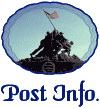


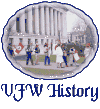

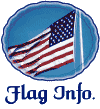

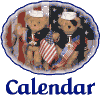
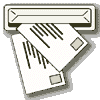 E-Mail
E-Mail